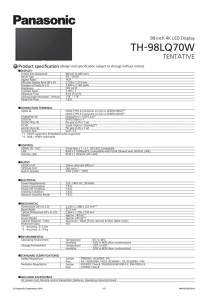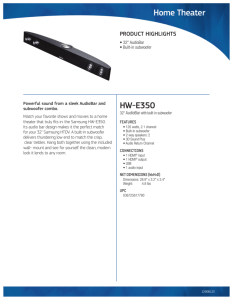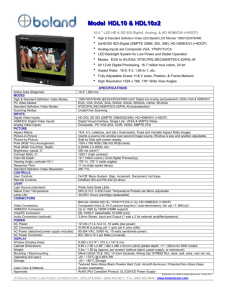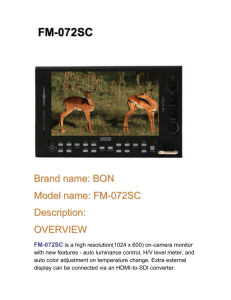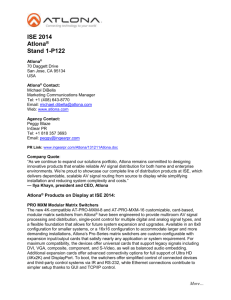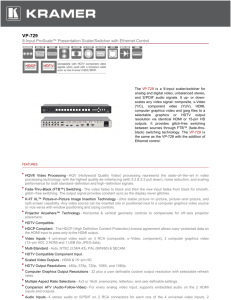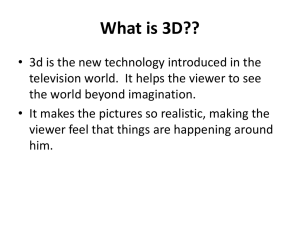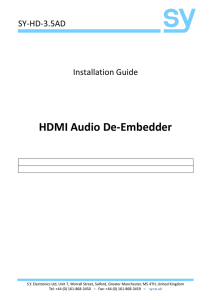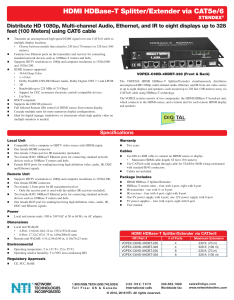Power Point
advertisement
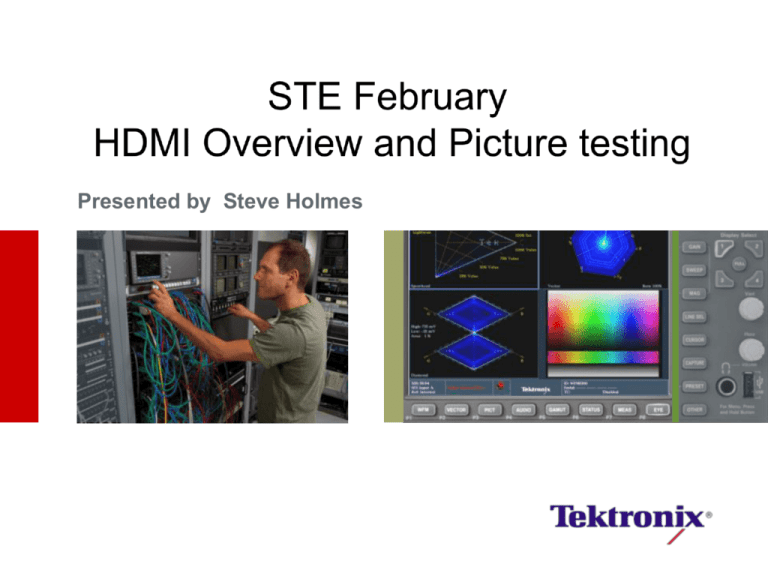
Presented by Steve Holmes Agenda Overview, HDMI 1.3, 1.4, 1.4A & 3D Deconstructing HDMI how is it related to SDI Where did my Anc data go Challenges in Monitoring Video over HDMI, HDCP, STB, OTT, CALM act, Tablet, Phone, ?? 2 HDMI what is it HDMI (High-Definition Multimedia Interface) – is a compact audio/video interface for transferring uncompressed digital audio/video data from an HDMI-compliant device ("the source device") to a compatible digital audio device, computer monitor, video projector, or digital television. HDMI is a digital replacement for existing analog video standards. – can be used for any uncompressed video format, including standard, enhanced, high definition, and 3D video signals; with up to 8 channels of compressed or uncompressed digital audio – HDMI can use HDCP (High-bandwidth Digital Content Protection) to encrypt the signal if required by the source device. CSS, CPRM and AACS require the use of HDCP on HDMI when playing back encrypted DVD Video, DVD Audio, HD DVD and Blu-ray Disc 4 HDCP what is it? HDCP (High-bandwidth Digital Content Protection) – HDMI can use HDCP to encrypt the signal, if it is required by the source device. Content Scramble System, (CSS), is a Digital Rights Management, (DRM), and encryption system employed on commercially produced DVD-Video discs. Utilizes a proprietary 40-bit stream cipher. Introduced around 1996. Content Protection for Recordable Media and Pre-Recorded Media, (CPRM/CPPM), mechanism for controlling the copying, moving and deletion of digital media on a personal computer or other digital player. A form of Digital Restrictions Management, (DRM), developed by the 4C Entity, LLC (consisting of IBM, Intel, Matsushita and Toshiba). The Advanced Access Content System, (AACS), intended to restrict access to and copying of the post DVD generation of optical discs. Released April 2005 and adopted as the access restriction scheme for HD DVD and Blu-ray Disc . Developed by a consortium that includes Disney, Intel, Microsoft, Panasonic, Warner Bros., IBM, Toshiba and Sony. 5 HDMI Connectors There are 5 types of HDMI Connectors. Type A, B, C, D, E Type A Standard HDMI Connector Type B has a 2 TMDS links. (Dual Link HDMI) for Supper High Resolutions >4K Type C is a smaller Version of Type A Type D is a Micro Version of Type A Type E is for Automotive applications 6 Type E Automotive HDMI Video Channels and Signals TMDS - Transition Minimized Differential Signaling – During the Video Data Period, the pixels of an active video line are transmitted during the horizontal and vertical blanking intervals, audio and auxiliary data are transmitted within a series of packets. The Control Period occurs between Video and Data Island periods.[ DDC - The Display Data Channel – a communication channel used by the HDMI source device to read the EEDID data from the HDMI sync device to learn what audio/video formats it supports. The standard mode speed (100 kbit/s) and allows optional support for fast mode speed (400 kbit/s) used for HD Content Protection. Utility Line – Is used for Ethernet and return Audio HPD - Hot Plug Detect CEC - Consumer Electronics Control – command and control up-to ten CEC-enabled devices 7 HDMI Channels 8 HDMI Licensing, LLC HDMI Versions 1.0 – 1.2a HDMI 1.0 was released on December 9, 2002 – A single cable digital Audio/Video interface with a TMDS bandwidth of 4.95 Gbit/S allowing 3.96 Gbit/S of video bandwidth, (1080p/60 UXGA) and 8 channel s of LPCM/ 192 kHz/24 bit Audio. HDMI 1.1 was released on May 20, 2004 – Added support for DVD Audio. HDMI 1.2 was released on August 8, 2005 – Added up to 8 channels of one bit audio and the Type A connector for computer sources. HDMI 1.2a was released on December 14, 2005 – Fully specifies Consumer Electronics Control. 9 HDMI Versions 1.3 – 1.3C HDMI 1.3 was released June 22, 2006 – Increased the single-link bandwidth to 340 MHz, (10.2 Gbit/S), increased deep color from 24 bit to 30 bit, 36 bit, 48 bit. Added Dolby TrueHD & DTS-HD audio and Audio/Video Sync. Defined category 1 & 2 cables and test procedures. Added type C connector. HDMI 1.3a was released on November 10, 2006 HDMI 1.3b was released on March 26, 2007 HDMI 1.3b1 was released on November 9, 2007 HDMI 1.3c was released on August 25, 2008 Each adding or changing specific items and some housekeeping. 10 HDMI 1.4 – 1.4a HDMI 1.4 – HDMI 1.4 cable has a new data channel that 1.3 and earlier did not have, for a Reverse Ethernet Channel and return audio. – HDMI 1.4 required that 3D displays support the frame packing 3D format at either 720p50 and 1080p24 or 720p60 and 1080p24 – Increase in the maximum resolution to 4K × 2K HDMI 1.4a – The big change from 1.4 was that 1.4a added side-by-side 3D horizontal at either 1080i50 or 1080i60 and top-and-bottom 3D at either 720p50 and 1080p24 or 720p60 and 1080p24. Change in the cable from 1.3 to 1.4, No change in the cable between 1.4 and 1.4a 11 HDMI 1.4 Ethernet Channel Change from 1.3 to 1.4 Some STB may check to see if Pin 14 is used, to know that the TV supports Side-by-Side 3D – Needs 1.4 HDMI cable – (HEC –data) 12 HDMI 1.4 4K x 2K Support Resolution on par with state-of-the-art Digital Cinema projectors used in the local multiplexes will be coming to your living rooms. 4K x 2K which represents resolutions of 3840x2160 and 4096x2160 will both be supported by HDMI 1.4 13 The Next Generation of 3D Video High Speed HDMI Cables w Ethernet The specification for this channel is not as challenging as for the higher speed 3.4Gbps TMDS pair and performance can be achieved by managing the physical cable design with particular consideration to the attenuation, common mode impedance and differential impedance. For more details on the HEAC channel performance targets, refer to the HEAC1 Supplement to the HDMI Specification. 14 HDMI signals Transition-minimized differential signaling (TMDS) is a technology for transmitting high-speed serial data and is used by the DVI and HDMI video interfaces, as well as other digital communication interfaces. The transmitter incorporates an advanced coding algorithm which reduces electromagnetic interference over copper cables and enables robust clock recovery at the receiver to achieve high skew tolerance for driving longer cables as well as shorter low cost cables. HDMI carries video, audio and auxiliary data via one of three modes, called the Video Data Period, the Data Island Period and the Control Period During the Video Data Period, the pixels of an active video line are transmitted. During the Data Island period (which occurs during the horizontal and vertical blanking intervals), audio and auxiliary data are transmitted within a series of packets. The Control Period occurs between Video and Data Island periods. This format is very Similar to SDI SAV-Video-EAV-Anc data Sample Frame of HDMI data 17 TMDS channels The Video carried across the link will be in one of 3 formats. RGB 4:4:4 YCBCR 4:4:4 YCBCR 4:2:2 8 Bit color is mandatory 10, 12, or 16 Bit color is optional. (Deep Color) if Deep Color is supported 12 Bit is minatory. (1.3) Video Levels Full Range, Limited Range SDI normal range 10 bit video is 64 to 940 SDI extended range 10 bit is 4 to 1019 HDMI see below Extended Range Y Cb Cr added in 1.4 19 Video Data Encoding Each 8 bits of video data is coded to 10 bits, using a type of 8b 10b coding. Each 10 Bit output is either XOR or XNOR to produce the fewest transitions. With LSb of output matching LSb of input. This output then may be inverted to produce the best DC balance of the transmitted stream. On Sources and Sinks any analog format that is supported will be supported in HDMI, frame rate and color space. All HDMI Sources and Sinks shall support RGB 4:4:4 All Sources shall support either YCBCR 4:4:4 or YCBCR 4:2:2. All Sinks shall support both YCBCR 4:4:4 and YCBCR 4:2:2 20 Video Data Encoding Transmit Video data in Receive Video data in 8B to 10B NOR XNOR Invert Video data out 21 XNOR NOR 10B to 8B Video data out Aux Data Information 22 Source Prod Desc: - indicates the Source Product Description that is the name of the manufacturer of the device, if present. Aspect Ratio: - indicates the aspect ratio of the image. ACP Packet: - indicates presence of Audio Content Protection Packet . ISRC Packet: - indicates presence of International Standard Recording Codes Gamut Packet: - indicates presence of . Vendor Specific Info: - indicates the presence of Vendor Specific Information. AVI Info: - indicates presence of AVI Info frame. Source Prod Desc Info: - indicates the presence of Source Product Description Information . Audio Info: - indicates presence of Audio Information. MPEG Source Info: - indicates presence of MPEG Source Information. Sent during Data Island periods Closed Captions In NTSC 608 captions are carried on Line 21 of the actual Video In HD SDI 708 captions are carried as a Data packet in the Vertical Ancillary space (608 are carried inside of the 708 packet) In MPEG 608 are on a Visible Picture line so it is coded with the Video In MPEG 708 Captions are carried as user data in the header of each Picture start code HDMI knows nothing about Captions!! It is STB or DVD/BluRay player that will overlay the captions on the video Content protection (HDCP) There are three main parts to HDCP’s security system. AKE – First, there is the cryptographic Authentication and Key Exchange (AKE). When a company wishes to produce an HDCP-compliant device, that company requests a set of keys from the HDCP licensing body. – After the licensing body has determined that the company’s product has been designed in a manner robust enough to withstand attacks and that the keys will be protected, the company will be given a series of unique secret keys. Hand Shake – Once both the playback device and the display device have settled on a value with which to encrypt the content, all the video content will be encrypted using this mutual value (this is the second part). Additionally, the system will check every couple of seconds to ensure the integrity of both the keys and the link. Key-revocation list – The third aspect of HDCP security is device renewability. This is the ability for media, streaming content, or even other devices to invalidate keys known to be a problem. Non HDCP receivers What happens when a Non HDCP receiver is hooked to a HDCP transmitter. – The transmitter tries to handshake the receiver does not respond and the transmitter shuts off in about 3 to 5 seconds. – We have not even started the content yet to see if it is protected or not. HDCP does not turn on and off. If a device is HDCP compliant the HDCP signaling is always on, even for not protected content. 25 How to see the Output of a HDMI device You need an HDCP compliant device.. Set Top Box HDCP compliant Waveform Monitor Cell Phone or Tablet How to see the Output of a HDMI device You need an HDCP compliant device.. HDCP compliant Picture Quality Tester Tektronix Transcoder Performance Verification Application Master Encoders Transcoders Fragmenters (Apple, MS, Adobe) • Tektronix PQA600 • Compare Video Quality pre and post Transcoder and at output of the player 29 To test the Quality of the Transcoder, capture the Origin Server output of the Master encoder (the mezzanine file) then Capture the output of the Transcoder at all of the Rates. Run the DMOS test on the PQA600A Tektronix Transcoder Performance Verification Application To test the Quality of the Master Encoders Transcoders Fragmenters (Apple, MS, Adobe) • Tektronix PQA600 • Compare Video Quality pre and post Transcoder and at output of the player 30 System End to End, capture the output of the Transcoder (use the captured file from the Origin previous test)Server then Capture the output of Playout device if you have the Test Client you can request the different rates. Run the DMOS test on the PQA600A Pre-introduction Technology Demonstration New Set Top Box Monitoring – WFM/WVR5250 HDMI (with HDCP) Content Monitor – Audio Loudness Monitoring for the CALM “Quick Check” – Black / Frozen Video Detection and valid color gamut – Advanced Error Logging with Web Server UI Full Control 2x SDI Switched Inputs SDI Out HDMI A/B Switched Input HDMI Out Video Session Screens Input Signaled format Measured Format Input & Output HDCP status 33 When things are not correct… Input format was signaled as 12b But received data was only 8b 34 When things are not correct… Input format was signaled as 1080P But received data was 601 color space Color is washed out 35 When things are not correct… Black levels lifted almost 50mV 36 When things are not correct… Color Bars not quite correct look at Red and Magenta Other colors are off also 37 EDID data dump 38 EDID Data fields Additional rows 0x8 to 0xf can contain CEA-861 extension block information that contains further audio and video descriptors. 39 EDID Row Column Value Description 0x0 0x0 - 0x7 00 FF FF FF FF FF FF 00 Fixed Header 0x0 0x8 - 0x9 XX XX Manufacturer ID 0x0 0xa - 0xb XX XX Manufacturer Product Code 0x0 0xc - 0xf XX XX XX XX Serial Number 0x1 0x0 XX Week of Manufacture 0x1 0x1 XX Year of Manufacture 0x1 0x2 01 EDID Version 0x1 0x3 03 EDID Version 0x1 0x4 - 0x8 XX XX XX XX XX Display Parameters 0x1 0x9 - 0xf XX XX XX XX XX XX XX Chromaticity Coordinates 0x2 0x0 - 0x2 XX XX XX Chromaticity Coordinates 0x2 0x3 - 0x5 XX XX XX Established timing bitmap 0x2 0x6 - 0xf XX...............XX Standard timing information 0x3 0x0 - 0x5 XX...............XX Standard timing information 0x3 0x6 - 0xf XX...............XX Descriptor 1 0x4 0x0 - 0x7 XX...............XX Descriptor 1 0x4 0x8 - 0xf XX...............XX Descriptor 2 0x5 0x0 - 0x9 XX...............XX Descriptor 2 0x5 0xa - 0xf XX...............XX Descriptor 3 0x6 0x0 - 0xb XX...............XX Descriptor 3 0x6 0xc - 0xf XX...............XX Descriptor 4 0x7 0x0 - 0xd XX...............XX Descriptor 4 0x7 0xe XX Number of Extensions 0x7 0xf XX Checksum Audio Monitoring Loudness Calm Spot Check Post - STB 41 Audio Monitoring Channel Mapping 42 CALM Act Spot Check A “spot check” requires monitoring 24 uninterrupted hours of programming with an audio loudness meter employing the measurement technique specified in the RP, and reviewing the records from that monitoring to detect any commercials transmitted in violation of the RP. To promote the reliability of the spot check, the station or MVPD must not provide prior notice to the programmer of the timing of the spot check. This requirement applies with respect to all spot checks (annual or in response to a Commission inquiry) on all programming, and for all stations and MVPDs – large and small. Stations (and occasionally MVPDs) may have multiple program suppliers for a single channel/stream of programming. In these cases, there may be no single 24-hour period in which all program suppliers are represented. In such cases, an annual spot check could consist of a series of loudness measurements over the course of a 7-day period, totaling no fewer than 24 hours that measure at least one program, in its entirety, provided by each non-certified programmer that supplies programming for that channel or stream of programming. CALM Act Spot Check To verify that the operator’s system is properly passing through loudness metadata, spot checking must be conducted after the signal has passed through the operator’s processing equipment (e.g., at the output of a set-top box or television receiver). If a problem is found, a station or MVPD may check multiple points in its reception and transmission process to determine the source of the noncompliance. For a spot check to be considered valid, a station or MVPD must be able to demonstrate appropriate maintenance records for the audio loudness meter, and to demonstrate, at the time of any enforcement inquiry, that appropriate spot checks had been ongoing. (FCC 11-182 Paragraph 38 Pg. 25) CALM Act 24 hour run 45 Date & Time LKFS Tue, 16 Oct 2012 10:00:08 Tue, 16 Oct 2012 11:00:15 Tue, 16 Oct 2012 12:00:45 Tue, 16 Oct 2012 13:00:45 Tue, 16 Oct 2012 14:01:44 Tue, 16 Oct 2012 15:04:46 Tue, 16 Oct 2012 16:04:46 Tue, 16 Oct 2012 17:04:46 Tue, 16 Oct 2012 18:04:46 Tue, 16 Oct 2012 19:04:46 Tue, 16 Oct 2012 20:00:08 Tue, 16 Oct 2012 21:00:15 Tue, 16 Oct 2012 22:00:45 Tue, 16 Oct 2012 23:00:45 Tue, 16 Oct 2012 00:01:44 Wed, 17 Oct 2012 01:04:46 Wed, 17 Oct 2012 02:04:46 Wed, 17 Oct 2012 03:04:46 Wed, 17 Oct 2012 04:04:46 Wed, 17 Oct 2012 05:04:46 Wed, 17 Oct 2012 06:00:08 Wed, 17 Oct 2012 07:00:15 Wed, 17 Oct 2012 08:00:45 Wed, 17 Oct 2012 09:00:45 -26 -26 -24 -26 -26 -27 -27 -27 -27 -27 -26 -26 -22 21 -25 -27 -27 -27 -27 -27 -26 -26 -24 -26 3D Formats Frame Pack 47 3D Formats Frame Pack Interlace 48 3D Formats Side by Side (Half) 49 3D Formats Top Bottom (Half) 50 3D Formats Field alternative 51 3D Formats Line alternative 52 3D Formats Side by Side (Full) 53
